第12章交通运输市场(2)
- 格式:ppt
- 大小:545.00 KB
- 文档页数:56
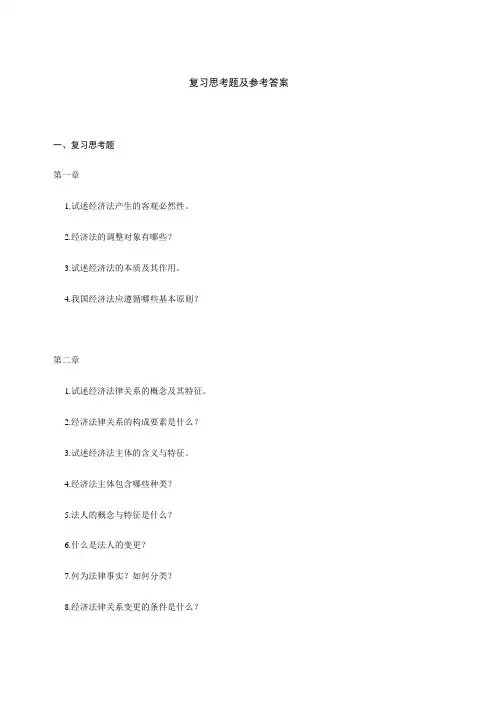
复习思考题及参考答案一、复习思考题第一章1.试述经济法产生的客观必然性。
2.经济法的调整对象有哪些?3.试述经济法的本质及其作用。
4.我国经济法应遵循哪些基本原则?第二章1.试述经济法律关系的概念及其特征。
2.经济法律关系的构成要素是什么?3.试述经济法主体的含义与特征。
4.经济法主体包含哪些种类?5.法人的概念与特征是什么?6.什么是法人的变更?7.何为法律事实?如何分类?8.经济法律关系变更的条件是什么?9.对经济法律关系实施保护的手段分别是什么?第三章1.什么是合同?合同有哪些特征?2.订立合同应遵循哪些原则?包括哪些程序?3.要约与要约邀请有何不同?4.合同的形式有哪几种?合同应包括哪些主要条款?5.合同履行应遵循哪些原则和规则?6.合同的担保形式有哪几种?分别有什么特征?7.合同变更和解除的条件是什么?合同终止的情况有哪些?8.什么是无效合同?根据合同无效的原因,无效合同有哪些种类?对无效合同应如何处理?9.承担违反合同责任的条件有哪些?免予承担违反合同责任的条件有哪些?违反合同的责任形式有哪些?第四章1. 简述建立和完善交通运输法规体系的必要性。
2. 建立和完善交通运输法规体系必须遵循哪些基本原则?3. 简述交通运输法律关系的主要特征。
4. 交通运输法律关系可以分为哪几类?5. 简述我国交通运输涉外法律框架的构想。
第五章1. 简述铁路法制建设不能适应铁路改革与发展的需要的具体表现。
2. 铁路沿线各级地方人民政府对铁路管理的内容有哪些?3. 简述铁路运输企业的性质。
4. 简述铁路运价的管理。
5. 铁路运输合同具有哪些特点?6. 简述铁路货物保价运输的概念及开办铁路货物保价运输的意义。
7. 简述铁路货物保价运输与铁路运输保险的区别。
8. 试述铁路保价运输的赔偿办法与赔偿时效的有关规定。
二、参考答案第一章1.试述经济法产生的客观必然性。
答:现代社会由于生产的社会化,经济关系的日益复杂化,各经济主体之间以及不同主体与国家之间经济利益和经济行为的冲突,要求政府从宏观上加强管理与监督,从而协调不同主体的利益,使经济管理社会化。
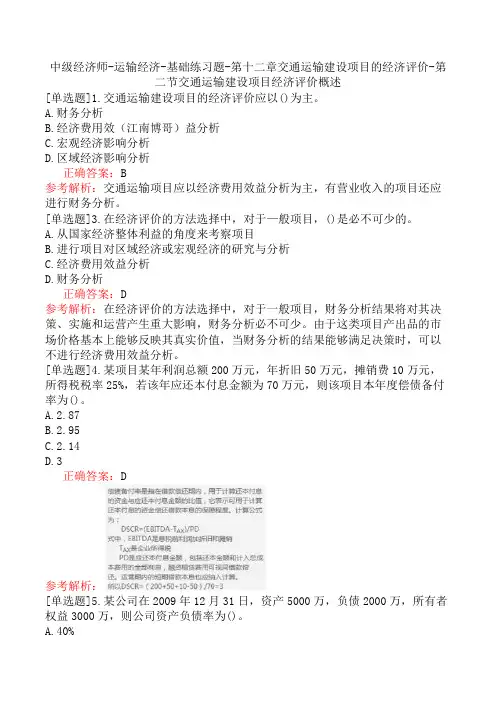
中级经济师-运输经济-基础练习题-第十二章交通运输建设项目的经济评价-第二节交通运输建设项目经济评价概述[单选题]1.交通运输建设项目的经济评价应以()为主。
A.财务分析B.经济费用效(江南博哥)益分析C.宏观经济影响分析D.区域经济影响分析正确答案:B参考解析:交通运输项目应以经济费用效益分析为主,有营业收入的项目还应进行财务分析。
[单选题]3.在经济评价的方法选择中,对于—般项目,()是必不可少的。
A.从国家经济整体利益的角度来考察项目B.进行项目对区域经济或宏观经济的研究与分析C.经济费用效益分析D.财务分析正确答案:D参考解析:在经济评价的方法选择中,对于一般项目,财务分析结果将对其决策、实施和运营产生重大影响,财务分析必不可少。
由于这类项目产出品的市场价格基本上能够反映其真实价值,当财务分析的结果能够满足决策时,可以不进行经济费用效益分析。
[单选题]4.某项目某年利润总额200万元,年折旧50万元,摊销费10万元,所得税税率25%,若该年应还本付息金额为70万元,则该项目本年度偿债备付率为()。
A.2.87B.2.95C.2.14D.3正确答案:D参考解析:[单选题]5.某公司在2009年12月31日,资产5000万,负债2000万,所有者权益3000万,则公司资产负债率为()。
A.40%B.50%C.60%D.100%正确答案:A参考解析:资产负债率是指各期末负债总额与资产总额的比率,是反映项目各年所面临的财务风险程度即偿债能力的指标。
其计算公式为:LOAR=TL/TA×100%式中,TL是期末负债总额,TA是期末资产总额.[单选题]6.交通运输建设项目的经济分析是从合理配置资源角度,分析项目投资的经济效率和对经济社会产生的贡献,评价交通运输建设项目的()。
A.财务生存能力B.财务盈利能力C.实施经济效果D.经济合理性正确答案:D参考解析:本题考查交通运输建设项目经济分析的概念。
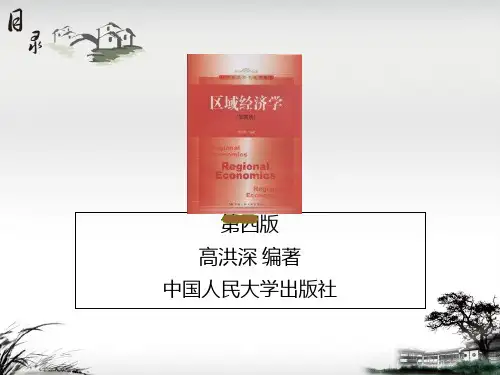
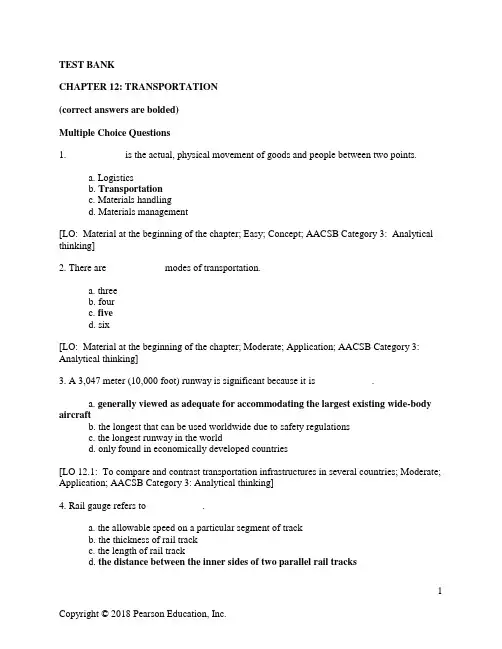
TEST BANKCHAPTER 12: TRANSPORTATION(correct answers are bolded)Multiple Choice Questions1. ___________ is the actual, physical movement of goods and people between two points.a. Logisticsb. Transportationc. Materials handlingd. Materials management[LO: Material at the beginning of the chapter; Easy; Concept; AACSB Category 3: Analytical thinking]2. There are ___________ modes of transportation.a. threeb. fourc. fived. six[LO: Material at the beginning of the chapter; Moderate; Application; AACSB Category 3: Analytical thinking]3. A 3,047 meter (10,000 foot) runway is significant because it is ___________.a. generally viewed as adequate for accommodating the largest existing wide-body aircraftb. the longest that can be used worldwide due to safety regulationsc. the longest runway in the worldd. only found in economically developed countries[LO 12.1: To compare and contrast transportation infrastructures in several countries; Moderate; Application; AACSB Category 3: Analytical thinking]4. Rail gauge refers to ___________.a. the allowable speed on a particular segment of trackb. the thickness of rail trackc. the length of rail trackd. the distance between the inner sides of two parallel rail tracks[LO 12.1: To compare and contrast transportation infrastructures in several countries; Moderate; Concept; AACSB Category 3: Analytical thinking]5. In terms of rail gauge, China primarily uses ___________ rail gauge whereas India primarily uses ___________ rail gauge.a. standard; broadb. broad; standardc. narrow; broadd. standard; narrow[LO 12.1: To compare and contrast transportation infrastructures in several countries; Difficult; Synthesis; AACSB Category 3: Analytical thinking]6. In the United States, ___________ account for the largest share of ton miles and ___________ account for the majority of freight revenues.a. railroads; railroadsb. trucks; trucksc. trucks; railroadsd. railroads; truck[LO 12.2: To identify the five modes of transportation and learn about their respective characteristics; Difficult; Synthesis; AACSB Category 3: Analytical thinking]7. ___________ refers to the terminal-to-terminal movement of freight or passengers.a. Materials handlingb. Accessorial servicec. Line-hauld. Order delivery[LO 12.2: To identify the five modes of transportation and learn about their respective characteristics; Moderate; Concept; AACSB Category 3: Analytical thinking]8. ___________ are generally the fastest form of transportation for shipments exceeding 600 miles.a. Less-than-truckload motor carriersb. Air carriersc. Parcel carriersd. Truckload motor carriers[LO 12.2: To identify the five modes of transportation and learn about their respective characteristics; Easy; Application; AACSB Category 3: Analytical thinking]9. Consignees are ___________.a. extremely large less-than-truckload carriersb. shippers of freightc. receivers of freightd. preferred suppliers[LO 12.2: To identify the five modes of transportation and learn about their respective characteristics; Moderate; Concept; AACSB Category 3: Analytical thinking]10. Accessorial service ___________.a. only applies to air transportationb. is associated with commodity ratesc. refers to additional service provided to apparel shipmentsd. is transportation service that is supplemental to the line-haul[LO 12.2: To identify the five modes of transportation and learn about their respective characteristics; Moderate; Concept; AACSB Category 3: Analytical thinking]11. Airfreight is best suited to transport ___________, ___________ products.a. high-value; lower-volumeb. low-value; lower-volumec. high-value; higher-volumed. low-value; higher-volume[LO 12.2: To identify the five modes of transportation and learn about their respective characteristics; Difficult; Synthesis; AACSB Category 3: Analytical thinking]12. Less-than-truckload motor carriers ___________.a. serve only regional marketsb. operate through a series of terminalsc. are exempt from hours-of-service regulationsd. carry the shipment directly from shipper to consignee[LO 12.2: To identify the five modes of transportation and learn about their respective characteristics; Moderate; Application; AACSB Category 3: Analytical thinking]13. All of the following are less-than-truckload (LTL) carriers except:a. YRC Freightb. Estes Expressc. UPS Freightd. Swift Transportation[LO 12.2: To identify the five modes of transportation and learn about their respective characteristics; Difficult; Synthesis; AACSB Category 3; Analytical thinking]14. Truckload carriers focus on shipments of greater than ___________ pounds.a. 10,000b. 15,000c. 17,500d. 20,000[LO 12.2: To identify the five modes of transportation and learn about their respective characteristics; Moderate; Application; AACSB Category 3: Analytical thinking]15. Each of the following statements is true except:a. Schneider National is an example of a truckload carrier.b. In truckload shipments, the shipper loads and the consignee unloads the trailer.c. A truckload shipment involves only one customer.d. Truckload carriers focus on shipments of greater than 10,000 pounds.[LO 12.2: To identify the five modes of transportation and learn about their respective characteristics; Difficult; Synthesis; AACSB Category 3: Analytical thinking]16. Hours-of-service (HOS) rules and speed limits have long been justified in the motor carrier industry on the basis of ___________.a. cost efficiencyb. customer requirementsc. operational efficiencyd. safety concerns[LO 12.2: To identify the five modes of transportation and learn about their respective characteristics; Difficult; Synthesis; AACSB Category 3: Analytical thinking]17. The primary advantage for motor carriers is ___________.a. reliabilityb. speedc. capabilityd. flexibility[LO 12.2: To identify the five modes of transportation and learn about their respective characteristics; Moderate; Application; AACSB Category 3: Analytical thinking]18. Airfreight is the costliest mode for freight transportation. What is the second most expensive mode of freight transportation?a. motor carrierb. waterc. raild. pipeline[LO 12.2: To identify the five modes of transportation and learn about their respective characteristics; Difficult; Synthesis; AACSB Category 3: Analytical thinking]19. ___________ is the most reliable form of transportation.a. Railb. Motor carrierc. Pipelined. Air[LO 12.2: To identify the five modes of transportation and learn about their respective characteristics; Difficult; Synthesis; AACSB Category 3: Analytical thinking]20. ___________ pipelines carry crude oil from gathering-line concentration points to the oil refineries.a. Productb. Trunkc. Slurryd. Collection[LO 12.2: To identify the five modes of transportation and learn about their respective characteristics; Moderate; Concept; AACSB Category 3: Analytical thinking]21. ___________ have a level of market concentration and dominance that is not found in the other modes.a. Railroadsb. Pipelinesc. Airlinesd. Motor carriers[LO 12.2: To identify the five modes of transportation and learn about their respective characteristics; Difficult; Synthesis; AACSB Category 3: Analytical thinking]22. Which mode is not the “best” or “worst” on any of th e six attributes (e.g., capability, flexibility, etc.) that were used to compare transport modes?a. railroadsb. water carriersc. pipelinesd. motor carriers[LO 12.2: To identify the five modes of transportation and learn about their respective characteristics; Difficult; Synthesis; AACSB Category 3: Analytical thinking]23. Railroads tend to transport ___________, ___________ shipments.a. higher-value; higher-volumeb. lower-value; lower-volumec. higher-value; lower-volumed. lower-value; higher-volume[LO 12.2: To identify the five modes of transportation and learn about their respective characteristics; Difficult; Synthesis; AACSB Category 3: Analytical thinking]24. Inland waterways in the United States are dredged to a depth of ___________ feet, which tends to be the minimum depth required for most barges.a. 15b. 12c. 9d. 6[LO 12.2: To identify the five modes of transportation and learn about their respective characteristics; Moderate; Application; AACSB Category 3: Analytical thinking]25. A ___________ raises or lowers barges so that they can meet the river’s level as they move upstream or downstream.a. container shipb. lockc. unit load deviced. towboat[LO 12.2: To identify the five modes of transportation and learn about their respective characteristics; Moderate; Concept; AACSB Category 3: Analytical thinking]26. The predominant commodity moved by barge transportation is ___________.a. grainb. coalc. iron ored. petroleum[LO 12.2: To identify the five modes of transportation and learn about their respective characteristics; Moderate; Application; AACSB Category 3: Analytical thinking]27. ___________ transportation occurs when two or more modes work closely together in an attempt to utilize the advantages of each mode while at the same time minimizing their disadvantages.a. Intermodalb. Relationalc. Intramodald. Collaborative[LO 12.3: To discuss intermodal transportation; Easy; Concept; AACSB Category 3: Analytical thinking]28. What container size is often used to rank water ports and measure containership capacity?a. 48-foot containerb. 40-foot containerc. 20-foot containere. 10-foot container[LO 12.3: To discuss intermodal transportation; Moderate; Application; AACSB Category 3: Analytical thinking]29. The primary advantage to land bridge service is ___________.a. less loss and damageb. reduced transit timesc. lower transportation costd. improved reliability[LO 12.3: To discuss intermodal transportation; Moderate; Application; AACSB Category 3: Analytical thinking]30. Freight forwarders ___________.a. are the same as shippers’ associationsb. consolidate the shipments of several carriersc. represent the consignees’ in terestsd. consolidate the shipments of several shippers[LO 12.4: To describe several types of transportation specialists; Moderate; Concept; AACSB Category 3: Analytical thinking]31. Shippers’ associations ___________.a. are the same as freight forwardersb. function in a manner similar to freight forwardersc. specialize in truckload shipmentsd. are used only for agricultural products[LO 12.4: To describe several types of transportation specialists; Moderate; Application; AACSB Category 3: Analytical thinking]32. A transportation broker ___________.a. looks to match a shipper’s freight with a carrier to transport itb. deals only with agricultural productsc. is the same as a freight forwarderd. tends to be spun off from carriers or management consulting firms[LO 12.4: To describe several types of transportation specialists; Moderate; Concept; AACSB Category 3: Analytical thinking]33. Firms that specialize in carrying packages that weigh up to 150 pounds are called___________.a. couriersb. accessorial carriersc. parcel carriersd. expedited carriers[LO 12.4: To describe several types of transportation specialists; Moderate; Concept; AACSB Category 3: Analytical thinking]34. What is the largest transportation company by revenues in the United States?a. FedExb. Union Pacificc. United Parcel Serviced. United Airlines[LO 12.4: To describe several types of transportation specialists; Moderate; Application; AACSB Category 3: Analytical thinking]35. In the United States, commercial airline pilots must retire at age ___________.a. 70b. 65c. 62d. 60[LO 12.5: To explain how different types of regulation impact transportation; Moderate; Application; AACSB Category 3: Analytical thinking]36. The U.S. ________ is the federal government body with primary responsibility for transportation safety regulation.a. Interstate Commerce Commission (ICC)b. Department of Commercec. Department of Homeland Securityd. Department of Transportation (DOT)[LO 12.5: To explain how different types of regulation impact transportation; Moderate; Application; AACSB Category 3: Analytical thinking]37. With respect to U.S. economic regulation, the ___________ has primary responsibility for resolving railroad rate and service disputes, reviewing potential rail mergers, and some jurisdiction over motor carriers, domestic water transportation, and pipelines.a. Surface Transportation Board (STB)b. Interstate Commerce Commission (ICC)c. Federal Trade Commissiond. Department of Commerce[LO 12.5: To explain how different types of regulation impact transportation; Moderate; Application; AACSB Category 3: Analytical thinking]38. Common carriers of transportation have ___________ obligations.a. sixb. fivec. fourd. three[LO 12.6: To identify the legal classification of transportation carriers; Moderate; Application; AACSB Category 3: Analytical thinking]39. Which of the following is not a legal classification of carriers?a. exemptb. contractc. privated. third-party transportation[LO 12.6: To identify the legal classification of transportation carriers; Difficult; Synthesis; AACSB Category 3: Analytical thinking]40. Private transportation is most prevalent in the ___________ industry.a. pipelineb. truckingc. railroadd. airline[LO 12.6: To identify the legal classification of transportation carriers; Difficult; Synthesis; AACSB Category 3: Analytical thinking]True-False Questions1.Transportation refers to the actual, physical movement of goods and people between twopoints. (True)[LO: Material at the beginning of the chapter; Easy; Concept; AACSB Category 3: Analytical thinking]2.There are four different modes of transportation. (False)[LO: Material at the beginning of the chapter; Moderate; Application; AACSB Category 3: Analytical thinking]3. A 10,000-foot (3,047 meter) runway is viewed as adequate for accommodating the largestexisting wide-body aircraft. (True)[LO 12.1: To compare and contrast transportation infrastructures in several countries; Moderate; Application; AACSB Category 3: Analytical thinking]4.Rail gauge refers to the thickness of rail track. (False)[LO 12.1: To compare and contrast transportation infrastructures in several countries; Moderate; Concept; AACSB Category 3: Analytical thinking]5.In the United States, motor carriers have the largest share of ton miles. (False)[LO 12.2: To identify the five modes of transportation and learn about their respective characteristics; Moderate; Application; AACSB Category 3: Analytical thinking]6.Air is generally the fastest mode of transportation for shipments exceeding 600 miles. (True) [LO 12.2: To identify the five modes of transportation and learn about their respective characteristics; Moderate; Synthesis; AACSB Category 3: Analytical thinking]7.Products that move by airfreight tend to be high in value and tend to require urgent delivery.(True)[LO 12.2: To identify the five modes of transportation and learn about their respective characteristics; Moderate; Synthesis; AACSB Category 3: Analytical thinking]8.Less-than-truckload shipments range from about 150 to 10,000 pounds. (True)[LO 12.2: To identify the five modes of transportation and learn about their respective characteristics; Moderate; Application; AACSB Category 3: Analytical thinking]9.Truckload freight moves through a carrier’s terminal(s). (False)[LO 12.2: To identify the five modes of transportation and learn about their respective characteristics; Moderate; Concept; AACSB Category 3: Analytical thinking]10.Hours-of-service rules and speed limits have generally been justified on the basis ofoperational efficiency. (False)[LO 12.2: To identify the five modes of transportation and learn about their respective characteristics; Moderate; Synthesis; AACSB Category 3: Analytical thinking]11.The primary advantage for motor carriers is flexibility (the ability to deliver the product tothe customer). (True)[LO 12.2: To identify the five modes of transportation and learn about their respective characteristics; Moderate; Application; AACSB Category 3: Analytical thinking]12.Pipelines are a unique mode of transportation because they are the only one without vehicles.(True)[LO 12.2: To identify the five modes of transportation and learn about their respective characteristics; Moderate; Application; AACSB Category 3: Analytical thinking]13.Railroads are considered the most reliable form of transportation. (False)[LO 12.2: To identify the five modes of transportation and learn about their respective characteristics; Difficult; Synthesis; AACSB Category 3: Analytical thinking]14.The U.S. railroad industry is dominated by four freight carriers. (True)[LO 12.2: To identify the five modes of transportation and learn about their respective characteristics; Moderate; Application; AACSB Category 3: Analytical thinking]15.Twelve feet of water is the minimum depth required for most barges. (False)[LO 12.2: To identify the five modes of transportation and learn about their respective characteristics; Moderate; Application; AACSB Category 3: Analytical thinking]16.A barge crane raises or lowers barges so they can meet the river’s level as they moveupstream or downstream. (False)[LO 12.2: To identify the five modes of transportation and learn about their respective characteristics; Moderate; Concept; AACSB Category 3: Analytical thinking]17.Barge transportation tends to be slow. (True)[LO 12.2: To identify the five modes of transportation and learn about their respective characteristics; Moderate; Application; AACSB Category 3: Analytical thinking]18.Of the modes with vehicles, railroads offer the greatest capacity, or volume, that can becarried at one time. (False)[LO 12.2: To identify the five modes of transportation and learn about their respective characteristics; Difficult; Synthesis; AACSB Category 3: Analytical thinking]19.With intermodal transportation, two or more modes work closely together in an attempt toutilize the advantages of each mode while at the same time minimizing their disadvantages.(True)[LO 12.3: To discuss intermodal transportation; Easy; Concept; AACSB Category 3: Analytical thinking]20.Airfreight containers are commonly referred to as pallets. (False)[LO 12.3: To discuss intermodal transportation; Easy; Concept; AACSB Category 3: Analytical thinking]21.A commonly used metric for measuring container volumes is the TEU (twenty-footequivalent unit). (True)[LO 12.3: To discuss intermodal transportation; Moderate; Application; AACSB Category 3: Analytical thinking]nd bridge services involve the use of surface transportation—generally railtransportation—between an origin and destination port. (True)[LO 12.3: To discuss intermodal transportation; Moderate; Concept; AACSB Category 3: Analytical thinking]23.Freight forwarders are the same thing as freight brokers. (False)[LO 12.4: To describe several types of transportation specialists; Moderate; Concept; AACSB Category 3: Analytical thinking]24.Freight forwarders sell freight at a higher rate per pound than they pay carriers to haul it.(True)[LO 12.4: To describe several types of transportation specialists; Moderate; Application; AACSB Category 3: Analytical thinking]25.The main benefit of shippers’ associ ations is one-stop shopping. (False)[LO 12.4: To describe several types of transportation specialists; Difficult; Synthesis; AACSB Category 3: Analytical thinking]26.A transportation broker looks to match a shipper’s freight with a carrier to transport it. (True) [LO 12.4: To describe several types of transportation specialists; Easy; Concept; AACSB Category 3: Analytical thinking]27.Parcels refer to packages weighing up to 100 pounds. (False)[LO 12.4: To describe several types of transportation specialists; Moderate; Concept; AACSB Category 3: Analytical thinking]28.U.S. commercial airline pilots face mandatory retirement at age 70. (False)[LO 12.5: To explain how different types of regulation impact transportation; Moderate; Application; AACSB Category 3: Analytical thinking]29.The level and degree of transportation regulation varies from country to country. (True) [LO 12.5: To explain how different types of regulation impact transportation; Moderate; Synthesis; AACSB Category 3: Analytical thinking]30.Environmental regulation of transportation is concerned with water, noise, and air pollution.(True)[LO 12.5: To explain how different types of regulation impact transportation; Moderate; Synthesis; AACSB Category 3: Analytical thinking]31.The U.S. Department of Homeland Security is the federal government body with primaryresponsibility for transportation safety regulation. (False)[LO 12.5: To explain how different types of regulation impact transportation; Moderate; Application; AACSB Category 3: Analytical thinking]32.U.S. pipelines are so safe that there is no federal safety agency assigned to regulate them.(False)[LO 12.5: To explain how different types of regulation impact transportation; Moderate; Application; AACSB Category 3: Analytical thinking]33.Economic regulation in transportation refers to control over business practices and activitiessuch as entry and exit, pricing, service, accounting and financial issues, and mergers and acquisitions. (True)[LO 12.5: To explain how different types of regulation impact transportation; Moderate; Concept; AACSB Category 3: Analytical thinking]34.The U.S. Department of Commerce has primary responsibility for resolving railroad rate andservice disputes as well as reviewing potential rail mergers. (False)[LO 12.5: To explain how different types of regulation impact transportation; Moderate; Application; AACSB Category 3: Analytical thinking]35.Since economic deregulation, transportation carriers are no longer constrained with respect tothe variety of service they can offer. (True)[LO 12.5: To explain how different types of regulation impact transportation; Moderate; Application; AACSB Category 3: Analytical thinking]36.Private carriers do not have to comply with environmental and safety regulations. (False) [LO 12.6: To identify the legal classification of transportation carriers; Moderate; Application; AACSB Category 3: Analytical thinking]mon carrier transportation companies have four specific obligations. (True)[LO 12.5: To identify the legal classification of transportation carriers; Easy; Application; AACSB Category 3: Analytical thinking]38.A contract carrier is under no obligation to render services to the general public. (True) [LO 12.5: To identify the legal classification of transportation carriers; Moderate; Application; AACSB Category 3: Analytical thinking]39.Private transportation is most prevalent in the pipeline industry. (False)[LO 12.5: To identify the legal classification of transportation carriers; Moderate; Application; AACSB Category 3: Analytical thinking]40.One disadvantage of private transportation is that managerial costs are often ignored orunderestimated. (True)[LO 12.5: To identify the legal classification of transportation carriers; Moderate; Synthesis; AACSB Category 3: Analytical thinking]。
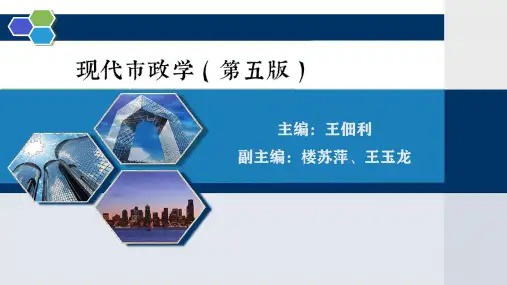
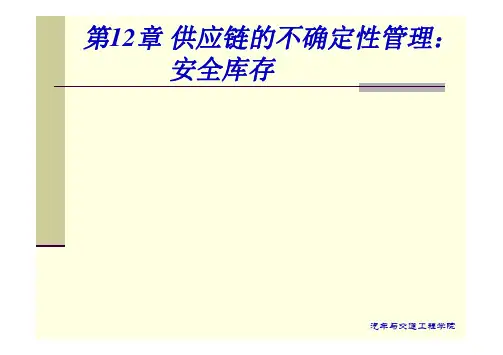
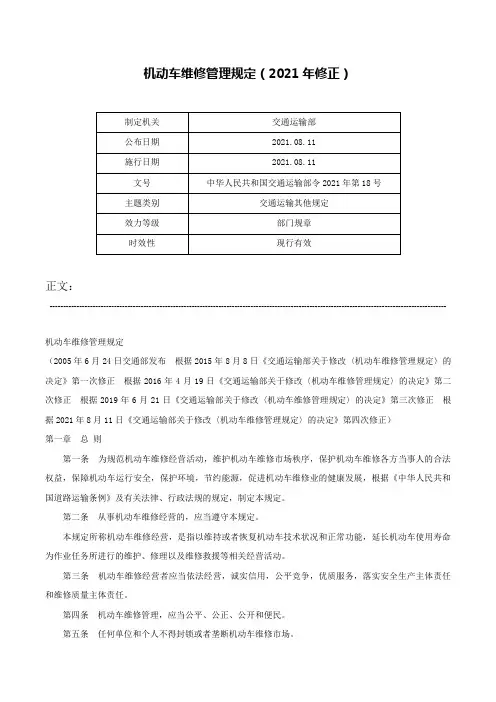
机动车维修管理规定(2021年修正)正文:----------------------------------------------------------------------------------------------------------------------------------------------------机动车维修管理规定(2005年6月24日交通部发布根据2015年8月8日《交通运输部关于修改〈机动车维修管理规定〉的决定》第一次修正根据2016年4月19日《交通运输部关于修改〈机动车维修管理规定〉的决定》第二次修正根据2019年6月21日《交通运输部关于修改〈机动车维修管理规定〉的决定》第三次修正根据2021年8月11日《交通运输部关于修改〈机动车维修管理规定〉的决定》第四次修正)第一章总则第一条为规范机动车维修经营活动,维护机动车维修市场秩序,保护机动车维修各方当事人的合法权益,保障机动车运行安全,保护环境,节约能源,促进机动车维修业的健康发展,根据《中华人民共和国道路运输条例》及有关法律、行政法规的规定,制定本规定。
第二条从事机动车维修经营的,应当遵守本规定。
本规定所称机动车维修经营,是指以维持或者恢复机动车技术状况和正常功能,延长机动车使用寿命为作业任务所进行的维护、修理以及维修救援等相关经营活动。
第三条机动车维修经营者应当依法经营,诚实信用,公平竞争,优质服务,落实安全生产主体责任和维修质量主体责任。
第四条机动车维修管理,应当公平、公正、公开和便民。
第五条任何单位和个人不得封锁或者垄断机动车维修市场。
托修方有权自主选择维修经营者进行维修。
除汽车生产厂家履行缺陷汽车产品召回、汽车质量“三包”责任外,任何单位和个人不得强制或者变相强制指定维修经营者。
鼓励机动车维修企业实行集约化、专业化、连锁经营,促进机动车维修业的合理分工和协调发展。
鼓励推广应用机动车维修环保、节能、不解体检测和故障诊断技术,推进行业信息化建设和救援、维修服务网络化建设,提高机动车维修行业整体素质,满足社会需要。
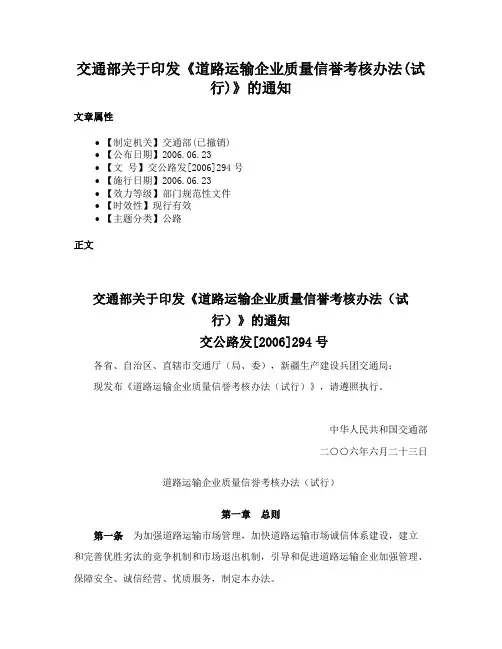
交通部关于印发《道路运输企业质量信誉考核办法(试行)》的通知文章属性•【制定机关】交通部(已撤销)•【公布日期】2006.06.23•【文号】交公路发[2006]294号•【施行日期】2006.06.23•【效力等级】部门规范性文件•【时效性】现行有效•【主题分类】公路正文交通部关于印发《道路运输企业质量信誉考核办法(试行)》的通知交公路发[2006]294号各省、自治区、直辖市交通厅(局、委),新疆生产建设兵团交通局:现发布《道路运输企业质量信誉考核办法(试行)》,请遵照执行。
中华人民共和国交通部二○○六年六月二十三日道路运输企业质量信誉考核办法(试行)第一章总则第一条为加强道路运输市场管理,加快道路运输市场诚信体系建设,建立和完善优胜劣汰的竞争机制和市场退出机制,引导和促进道路运输企业加强管理、保障安全、诚信经营、优质服务,制定本办法。
第二条对道路旅客运输企业、道路货物运输企业(以下统称为道路运输企业)进行质量信誉考核,应当遵守本办法。
本办法所称的质量信誉考核,是指在考核年度内对道路运输企业的安全生产、经营行为、服务质量、管理水平和履行社会责任等方面进行的综合评价。
本办法所称的道路客运企业,是指从事班车客运、包车客运或旅游客运业务的企业;道路货运企业是指从事营业性道路货物运输或从事为本单位服务的非经营性道路危险货物运输的企业。
第三条道路运输企业质量信誉考核工作应当遵循公开、公平、公正的原则。
第四条道路运输企业应当自觉遵守国家有关法律、法规及规章,加强管理,诚信经营,履行社会责任,为社会提供安全、优质的运输服务。
各级交通主管部门和道路运输管理机构应当鼓励和支持质量信誉良好的道路运输企业发展。
第五条交通部主管全国道路运输企业质量信誉考核工作。
县级以上人民政府交通主管部门负责组织领导本行政区域的道路运输企业质量信誉考核工作。
道路运输企业质量信誉考核工作具体由省级道路运输管理机构统一组织开展,市、县级道路运输管理机构按本办法规定的职责,做好相关工作。
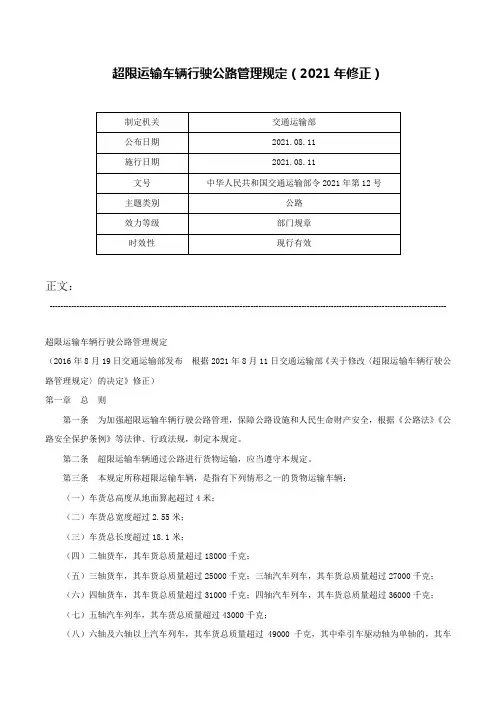
超限运输车辆行驶公路管理规定(2021年修正)正文:----------------------------------------------------------------------------------------------------------------------------------------------------超限运输车辆行驶公路管理规定(2016年8月19日交通运输部发布根据2021年8月11日交通运输部《关于修改〈超限运输车辆行驶公路管理规定〉的决定》修正)第一章总则第一条为加强超限运输车辆行驶公路管理,保障公路设施和人民生命财产安全,根据《公路法》《公路安全保护条例》等法律、行政法规,制定本规定。
第二条超限运输车辆通过公路进行货物运输,应当遵守本规定。
第三条本规定所称超限运输车辆,是指有下列情形之一的货物运输车辆:(一)车货总高度从地面算起超过4米;(二)车货总宽度超过2.55米;(三)车货总长度超过18.1米;(四)二轴货车,其车货总质量超过18000千克;(五)三轴货车,其车货总质量超过25000千克;三轴汽车列车,其车货总质量超过27000千克;(六)四轴货车,其车货总质量超过31000千克;四轴汽车列车,其车货总质量超过36000千克;(七)五轴汽车列车,其车货总质量超过43000千克;(八)六轴及六轴以上汽车列车,其车货总质量超过49000千克,其中牵引车驱动轴为单轴的,其车货总质量超过46000千克。
前款规定的限定标准的认定,还应当遵守下列要求:(一)二轴组按照二个轴计算,三轴组按照三个轴计算;(二)除驱动轴外,二轴组、三轴组以及半挂车和全挂车的车轴每侧轮胎按照双轮胎计算,若每轴每侧轮胎为单轮胎,限定标准减少3000千克,但安装符合国家有关标准的加宽轮胎的除外;(三)车辆最大允许总质量不应超过各车轴最大允许轴荷之和;(四)拖拉机、农用车、低速货车,以行驶证核定的总质量为限定标准;(五)符合《汽车、挂车及汽车列车外廓尺寸、轴荷及质量限值》(GB1589)规定的冷藏车、汽车列车、安装空气悬架的车辆,以及专用作业车,不认定为超限运输车辆。
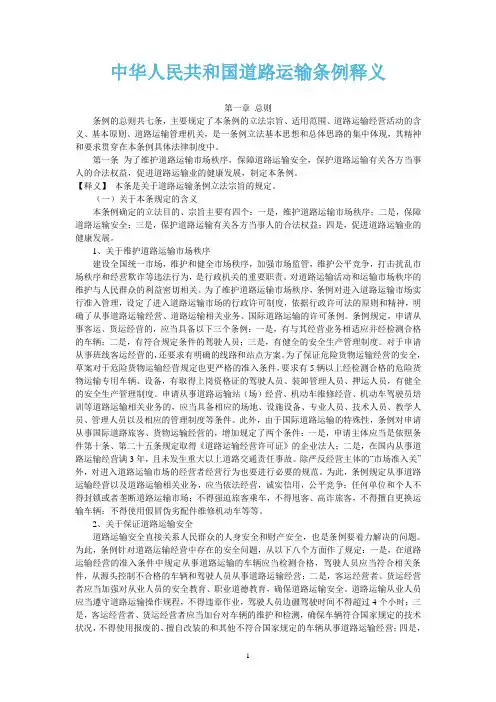
中华人民共和国道路运输条例释义第一章总则条例的总则共七条,主要规定了本条例的立法宗旨、适用范围、道路运输经营活动的含义、基本原则、道路运输管理机关,是一条例立法基本思想和总体思路的集中体现,其精神和要求贯穿在本条例具体法律制度中。
第一条为了维护道路运输市场秩序,保障道路运输安全,保护道路运输有关各方当事人的合法权益,促进道路运输业的健康发展,制定本条例。
【释义】本条是关于道路运输条例立法宗旨的规定。
(一)关于本条规定的含义本条例确定的立法目的、宗旨主要有四个:一是,维护道路运输市场秩序;二是,保障道路运输安全;三是,保护道路运输有关各方当事人的合法权益;四是,促进道路运输业的健康发展。
1、关于维护道路运输市场秩序建设全国统一市场,维护和健全市场秩序,加强市场监管,维护公平竞争,打击扰乱市场秩序和经营欺诈等违法行为,是行政机关的重要职责。
对道路运输活动和运输市场秩序的维护与人民群众的利益密切相关。
为了维护道路运输市场秩序,条例对进入道路运输市场实行准入管理,设定了进入道路运输市场的行政许可制度,依据行政许可法的原则和精神,明确了从事道路运输经营、道路运输相关业务、国际道路运输的许可条例。
条例规定,申请从事客运、货运经营的,应当具备以下三个条例:一是,有与其经营业务相适应并经检测合格的车辆;二是,有符合规定条件的驾驶人员;三是,有健全的安全生产管理制度。
对于申请从事班线客运经营的,还要求有明确的线路和站点方案。
为了保证危险货物运输经营的安全,草案对于危险货物运输经营规定也更严格的准入条件,要求有5辆以上经检测合格的危险货物运输专用车辆、设备,有取得上岗资格证的驾驶人员、装卸管理人员、押运人员,有健全的安全生产管理制度。
申请从事道路运输站(场)经营、机动车维修经营、机动车驾驶员培训等道路运输相关业务的,应当具备相应的场地、设施设备、专业人员、技术人员、教学人员、管理人员以及相应的管理制度等条件。
此外,由于国际道路运输的特殊性,条例对申请从事国际道路旅客、货物运输经营的,增加规定了两个条件:一是,申请主体应当是依照条件第十条、第二十五条规定取得《道路运输经营许可证》的企业法人;二是,在国内从事道路运输经营满3年,且未发生重大以上道路交通责任事故。
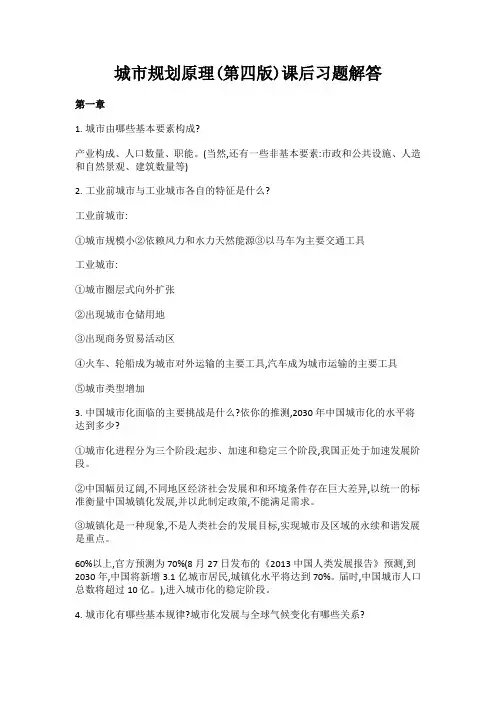
城市规划原理(第四版)课后习题解答第一章1.城市由哪些基本要素构成?产业构成、人口数量、职能。
(当然,还有一些非基本要素:市政和公共设施、人造和自然景观、建筑数量等)2.工业前城市与工业城市各自的特征是什么?工业前城市:①城市规模小②依赖风力和水力天然能源③以马车为主要交通工具工业城市:①城市圈层式向外扩张②出现城市仓储用地③出现商务贸易活动区④火车、轮船成为城市对外运输的主要工具,汽车成为城市运输的主要工具⑤城市类型增加3.中国城市化面临的主要挑战是什么?依你的推测,2030年中国城市化的水平将达到多少?①城市化进程分为三个阶段:起步、加速和稳定三个阶段,我国正处于加速发展阶段。
②中国幅员辽阔,不同地区经济社会发展和和环境条件存在巨大差异,以统一的标准衡量中国城镇化发展,并以此制定政策,不能满足需求。
③城镇化是一种现象,不是人类社会的发展目标,实现城市及区域的永续和谐发展是重点。
60%以上,官方预测为70%(8月27日发布的《2013中国人类发展报告》预测,到2030年,中国将新增3.1亿城市居民,城镇化水平将达到70%。
届时,中国城市人口总数将超过10亿。
),进入城市化的稳定阶段。
4.城市化有哪些基本规律?城市化发展与全球气候变化有哪些关系?①城市人口占总人口的比重不断上升。
②产业结构由第一产业向第二三产业转变。
③农业人口剩余推动城市化发展。
①城市用地增加,农业用地、森林、湿地等非城市用地减少。
②城市化耗费大量煤、石油等非天然能源,造成环境污染。
③城市化同时促进科技发展,产生电池、塑料、建筑垃圾等人造污染物。
第二章1.中国古代的城市格局反映了哪些重要的城市规划思想?①整体观念和长远发展(《管子》提出功能分区)、(《商君书》提出从城乡关系、区域经济、交通布局考虑)②人工环境和自然环境和谐【道家】(战国时代,吴国国都阖闾城建设,伍子胥提出“相土尝水,象天法地”)、(秦统一中国,规划时,也提出“象天法地”,强调方位)、(三国时期,吴国国都选址金陵,“以石头山、长江险要为界,依托玄武湖防御”)③严格有序的城市等级制度:中轴对称,道路分等级等【儒家】(周礼考工记,周王城建造,按封建等级)、(曹邺魏城、隋唐长安城、元大都皆是依据周王城而建)2.你认为哪些古代经典城市的规划案例,对未来的城市发展仍然有重要意义?①曹魏邺城,采用功能分区布局。
《道路运输车辆动态监督管理办法》(交通运输部令2016年第55号)修改交通运输部公安部国家安全生产监督管理总局关于修改《道路运输车辆动态监督管理办法》的决定(交通运输部令2016年第55号)《交通运输部公安部国家安全生产监督管理总局关于修改〈道路运输车辆动态监督管理办法〉的决定》已于2016年4月7日经交通运输部第7次部务会议通过,现予公布。
交通运输部部长杨传堂公安部部长郭声琨国家安全生产监督管理总局局长杨焕宁2016年4月20日交通运输部公安部国家安全生产监督管理总局关于修改《道路运输车辆动态监督管理办法》的决定交通运输部、公安部、国家安全生产监督管理总局决定对《道路运输车辆动态监督管理办法》(交通运输部公安部国家安全生产监督管理总局令2014年第5号)作如下修改:删除第十一条第(一)项中的“组织机构代码证、”。
本决定自2016年4月20日起施行。
《道路运输车辆动态监督管理办法》根据本决定作相应修正,重新公布。
道路运输车辆动态监督管理办法(2014年1月28日交通运输部公安部国家安全生产监督管理总局发布根据2016年4月20日《交通运输部公安部国家安全生产监督管理总局关于修改〈道路运输车辆动态监督管理办法〉的决定》修正)第一章总则第一条为加强道路运输车辆动态监督管理,预防和减少道路交通事故,依据《中华人民共和国安全生产法》《中华人民共和国道路交通安全法实施条例》《中华人民共和国道路运输条例》等有关法律法规,制定本办法。
第二条道路运输车辆安装、使用具有行驶记录功能的卫星定位装置(以下简称卫星定位装置)以及相关安全监督管理活动,适用本办法。
第三条本办法所称道路运输车辆,包括用于公路营运的载客汽车、危险货物运输车辆、半挂牵引车以及重型载货汽车(总质量为12吨及以上的普通货运车辆)。
第四条道路运输车辆动态监督管理应当遵循企业监控、政府监管、联网联控的原则。
第五条道路运输管理机构、公安机关交通管理部门、安全监管部门依据法定职责,对道路运输车辆动态监控工作实施联合监督管理。
道路旅客运输及客运站管理规定(2016年修正)文章属性•【制定机关】交通运输部•【公布日期】2016.04.11•【文号】交通运输部令2016年第34号•【施行日期】2005.08.01•【效力等级】部门规章•【时效性】失效•【主题分类】公路正文道路旅客运输及客运站管理规定(2005年7月12日交通部发布根据2008年7月23日交通运输部《关于修改〈道路旅客运输及客运站管理规定〉的决定》第一次修正根据2009年4月20日交通运输部《关于修改〈道路旅客运输及客运站管理规定〉的决定》第二次修正根据2012年3月14日交通运输部《关于修改〈道路旅客运输及客运站管理规定〉的决定》第三次修正根据2012年12月11日交通运输部《关于修改〈道路旅客运输及客运站管理规定〉的决定》第四次修正根据2016年4月11日交通运输部《关于修改〈道路旅客运输及客运站管理规定〉的决定》第五次修正)第一章总则第一条为规范道路旅客运输及道路旅客运输站经营活动,维护道路旅客运输市场秩序,保障道路旅客运输安全,保护旅客和经营者的合法权益,依据《中华人民共和国道路运输条例》及有关法律、行政法规的规定,制定本规定。
第二条从事道路旅客运输(以下简称道路客运)经营以及道路旅客运输站(以下简称客运站)经营的,应当遵守本规定。
第三条本规定所称道路客运经营,是指用客车运送旅客、为社会公众提供服务、具有商业性质的道路客运活动,包括班车(加班车)客运、包车客运、旅游客运。
(一)班车客运是指营运客车在城乡道路上按照固定的线路、时间、站点、班次运行的一种客运方式,包括直达班车客运和普通班车客运。
加班车客运是班车客运的一种补充形式,是在客运班车不能满足需要或者无法正常运营时,临时增加或者调配客车按客运班车的线路、站点运行的方式。
(二)包车客运是指以运送团体旅客为目的,将客车包租给用户安排使用,提供驾驶劳务,按照约定的起始地、目的地和路线行驶,按行驶里程或者包用时间计费并统一支付费用的一种客运方式。
重庆市道路运输管理条例【发文字号】市人民代表大会常务委员会公告第154号【发布部门】重庆市人大(含常委会)【公布日期】2000.12.19【实施日期】2001.02.01【时效性】失效【效力级别】省级地方性法规重庆市人民代表大会常务委员会公告(第154号)《重庆市道路运输管理条例》2000年12月19日经重庆市第一届人民代表大会常务委员会第二十九次会议通过,现予公布。
自2001年2月1日起施行。
2000年12月19日重庆市道路运输管理条例(2000年12月19日重庆市第一届人民代表大会常务委员会第二十九次会议通过)第一章总则第一条为维护道路运输市场秩序,建立统一、开放、竞争、有序的道路运输市场,规范经营行为,保障道路运输经营者及其服务对象的合法权益,促进道路运输业的健康发展,根据国家有关法律、行政规定,结合本市实际,制定本条例。
第二条本条例所称道路运输,是指从事道路旅客运输、道路货物运输以及相关的车辆维修、搬运装卸、驾驶员培训和其他运输服务活动。
凡在本市行政区域内从事营业性道路运输管理、经营的单位和个人及经营服务对象,均应遵守本条例。
第三条市交通行政主管部门主管本市的道路运输管理工作。
区、县(自治县、市)交通行政主管部门按照规定的职责负责本行政区域的道路运输管理工作。
市和区、县(自治县、市)交通行政主管部门的道路运输管理机构负责本行政区域的道路运输具体管理工作。
公安、市政、农机、工商、税务、物价、环保、质量技术监督等行政部门按照各自的职责,协同交通行政主管部门实施本条例。
第四条市交通行政主管部门应当根据本市经济和社会发展的需要,编制道路运输发展规划,报市人民政府批准后,纳入全市国民经济和社会发展计划以及城市总体规划,并组织实施。
区、县(自治县、市)人民政府应当根据本行政区域经济和社会发展的需要,编制道路运输发展规划,并与市人民政府制定的道路运输发展规划相协调。
第五条道路运输实行公开、公平、公正和统一管理、协调发展、各种经营主体平等竞争的原则,禁止不正当竞争。
第一章绪论1.填空题(1)交通运输具有(空间位移(运动))、(运输工具)和(运输服务费用)这3个要素。
(2)按照载运工具和运输方式的不同,交通运输系统由(公路)、(铁路)、(水路)、(航空)、(管道)5种基本运输方式组成。
2.简答题(1)简述交通运输的生产特点。
交通运输的生产特点主要现在:①运输生产是在流通过程中完成的。
②远输生产过程不改变劳动对象的物理、化学性质和形态,而只改变运输对象(客、货)的空间位置,并不创造新的产品。
③在运输生产过程中,劳动工具(运输工具)和劳动对象(客、货)是同时运动的,它创造的产品(客、货在空间上的位移)不具有物质实体,并在运输生产过程中同时被消耗掉。
④运输产品计量的特殊性。
⑤交通运输的劳动对象十分庞杂。
(2)交通运输工程学的研究对象是什么?交通远输工程学主要研究对象包括:①交通运输系统的总体规划、运行技术及运输管理。
②铁路、公路、城市道路、机场、港口等交通基础设施的设计、施工、养护。
③交通运输中的运载工具。
④交通运输安全。
⑤交通信息控制系统的智能化、综合化。
⑥交通运输的可持续发展。
(3)简述交通运输系统的构成要素及构成方式。
交通运输系统的构成要素包括:①载运工具;②站场:;③线路;④交通控制和管理系系统;⑤设施管理系统;⑥信息管理系统。
交通运输系统由铁路、公路、水运、航空和管道这五种基本运输方式构成。
(4)简述现代交通运输的发展趋势。
现代交通运输的发展趋势包括:①专门化;②大型化;③高速化;④环保化;⑤智能化。
第二章运输需求分析与交通工程基础1.填空题(1)运输需求必须满足两个条件,即(具有突现位移的愿望)和(具备支付能力)。
(2)按照运输需求实现的方式不同,运输需求可以分为(公路)、(铁路)、(水运)、(航空)、(管道)等运输需求。
(3)按运输需求实体的类型不同,运输需求可以分为(空运需求)和(货运需求)(4)运输量是(运输需求)、(运输供给)和(服务水平)相互作用的结果。
交通运输行业智能交通与新能源汽车推广方案第1章引言 (3)1.1 背景与意义 (3)1.2 目标与范围 (3)第2章交通运输行业现状分析 (3)2.1 行业发展概况 (3)2.2 智能交通发展现状 (4)2.3 新能源汽车发展现状 (4)第3章智能交通系统构建 (4)3.1 智能交通系统框架 (4)3.1.1 系统架构 (5)3.1.2 核心模块 (5)3.2 关键技术分析 (5)3.2.1 数据采集与处理技术 (5)3.2.2 通信技术 (5)3.2.3 智能决策技术 (5)3.2.4 车辆控制技术 (6)3.3 产业链整合与发展 (6)3.3.1 政策支持与引导 (6)3.3.2 技术创新与研发 (6)3.3.3 产业协同发展 (6)3.3.4 市场推广与应用 (6)3.3.5 人才培养与交流 (6)第4章新能源汽车技术路线 (6)4.1 新能源汽车类型及特点 (6)4.2 电池技术 (7)4.3 驱动系统技术 (7)第5章智能交通与新能源汽车融合发展 (7)5.1 融合发展的必要性 (7)5.1.1 提高能源利用效率 (8)5.1.2 缓解交通拥堵 (8)5.1.3 促进交通运输行业转型升级 (8)5.2 融合发展模式摸索 (8)5.2.1 技术创新驱动模式 (8)5.2.2 政策引导与市场驱动模式 (8)5.2.3 产业链协同发展模式 (8)5.3 案例分析 (8)5.3.1 基本情况 (8)5.3.2 融合发展措施 (8)5.3.3 实施效果 (9)第6章政策与法规支持 (9)6.1 政策环境分析 (9)6.1.1 国家层面政策 (9)6.1.2 地方政策 (9)6.2 法规与标准体系建设 (9)6.2.1 法规体系建设 (9)6.2.2 标准体系建设 (9)6.3 政策建议 (10)6.3.1 完善政策体系 (10)6.3.2 强化法规与标准体系建设 (10)6.3.3 加大政策宣传与培训力度 (10)6.3.4 加强政策协同与监管 (10)第7章推广策略与实施 (10)7.1 市场需求分析 (10)7.1.1 消费者需求 (10)7.1.2 行业发展趋势 (10)7.2 推广策略制定 (10)7.2.1 政策扶持 (10)7.2.2 市场培育 (11)7.2.3 产品创新 (11)7.2.4 基础设施建设 (11)7.3 实施计划与推进 (11)7.3.1 短期目标(12年) (11)7.3.2 中期目标(35年) (11)7.3.3 长期目标(5年以上) (11)第8章产业协同发展 (12)8.1 产业链协同模式 (12)8.1.1 概述 (12)8.1.2 产业链协同模式构建 (12)8.2 产业联盟构建 (12)8.2.1 概述 (12)8.2.2 产业联盟构建策略 (12)8.3 产业创新与孵化 (12)8.3.1 概述 (12)8.3.2 产业创新与孵化策略 (13)第9章监管与评估 (13)9.1 监管体系建设 (13)9.2 安全保障措施 (13)9.3 效果评估与优化 (13)第10章展望与建议 (14)10.1 行业发展趋势 (14)10.2 前景预测与挑战 (14)10.3 发展建议与政策展望 (15)第1章引言1.1 背景与意义经济的快速发展和城市化进程的加快,交通运输行业面临着越来越大的压力。